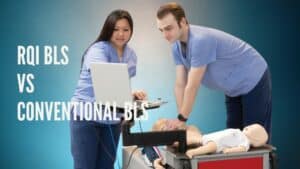Differences Between an EMT and a Paramedic
You’ve seen them on the frontlines of critical medical emergencies. When a medical disaster strikes, you can count on EMTs and paramedics to handle the situation with ease. However, there’s a lot of confusion about the differences between an EMT and a paramedic – or are they the same? They’re both trained professionals within the Emergency Medical Services (EMS) System, along with other first responders like firefighters, nurses, and police officers. So, what’s the difference? Whether you’re exploring the medical field or itching to make a career change, we’ll help you navigate the differences between an EMT and a paramedic.
EMT vs. Paramedic
Most health professionals know EMT and paramedic training is different, but who really knows what to expect when you walk through those doors for the first time? In fact, EMTs and paramedics share a lot of the same prerequisites, certifications, and training. Both require candidates to meet all prerequisites for attending a state-approved EMT or paramedic course. Students must also successfully complete their course and certify with the National Registry of Emergency Medical Technicians (NREMT) after passing the NREMT exam within two years of completing their course.
Sounds like a lot? For paramedics, there’s still a lot more ground to cover. As the highest level of prehospital care providers, paramedics must complete additional training on top of the EMT basics. This means there are several things a paramedic is trained and authorized to do that an EMT is not.
Let’s take a closer look at the differences between an EMT and a paramedic.
What is an EMT?
Emergency medical technicians (EMTs) are the most common care providers in the field of emergency medical services. They’re often described as the entry-level care provider, but don’t let the term “entry-level” fool you. EMTs are extensively trained in the essential skills necessary to assess life-or-death situations. They’re equipped to handle medical emergencies such as CPR, stopping external bleeding, and administering oxygen. EMTs work on ambulances and respond to 911 calls, where their skills are put to the test – and are often the difference between life or death for millions of Americans each day.
What are the Requirements to Become an EMT?
Ready to become an EMT, but don’t know where to get started? The good news is you don’t need any prior medical experience. You’ll gain the necessary skills and medical knowledge as part of your EMT training. The basic requirements vary between states and programs, but the EMT prerequisites in California include:
- Be age 18 or older
- Obtain a high school diploma or GED
- Be CPR certified
- Attend an accredited EMT school
- Pass the NREMT exams
Attending an EMT program is the crucial stepping stone to becoming an EMT. Training is rigorous and takes a lot of time – usually between 120 to 150 hours of instruction. There are long hours and many nights spent studying, learning medical skills, and taking exams. But the rewarding career of helping save lives in everyday emergencies is worth it.
Most accredited EMT training programs are offered at hospitals, emergency care training facilities, and community colleges. The Commission on Accreditation of Allied Health Education Programs provides a list of state-approved EMT schools to help narrow down your search.
What is a Paramedic?
While most people only know a little about what paramedics do, the truth is that paramedics make up an essential part of our healthcare system. Paramedics are at the highest level of pre-hospital emergency medical care. Like EMTs, they provide first aid and ambulance response to sick or injured patients. However, paramedics are skilled in a wider range of advanced medical and non-medical skills, which makes them invaluable for the emergency response system. Paramedics treat patients with infectious diseases, insert IVs, and provide oxygen support via breathing tubes and ventilation devices.
Paramedics build upon their training as EMTs to provide advanced medical care that EMTs are not authorized to provide, such as treating patients with infectious diseases and administering medication. They are trained to use complex life support equipment like defibrillators and perform procedures like tracheostomies, inserting IVs, and provide oxygen support using breathing tubes and ventilation devices. Paramedics are also more intensively educated on medical topics including anatomy and physiology, medical procedures, and cardiology.
What are the Requirements to Become a Paramedic?
Becoming a paramedic is not easy. It’s an industry that takes years of study and dedication. First, you must undergo all the training and certifications to become an EMT. But it doesn’t stop there – after becoming EMT certified, you’ll have to take thousands of hours of training to become a paramedic. This is no exaggeration – paramedic courses require between 1,200 to 1,800 hours of classes, which can take over one to two years to complete. Paramedic courses generally consist of classroom instruction, clinical training, and on-the-job experience. Some programs may also issue an Associate’s Degree for the completion of your hard work.
There’s no doubt it takes tremendous self-discipline and motivation to become a paramedic, but with great effort comes a rewarding career making a positive impact on the lives around you.
Start Your Career as an EMT or Paramedic with SureFire CPR
Ready to join the ranks as an EMT or paramedic in California? Our team at SureFire CPR will help you take the first steps toward your career in EMS. With our BLS certification courses, you’ll learn everything you need to prepare for an accredited EMT training program. Have questions about the right course for you? Contact us today to get started!







